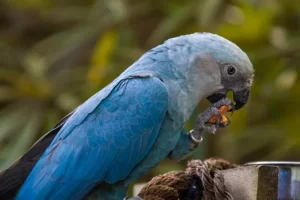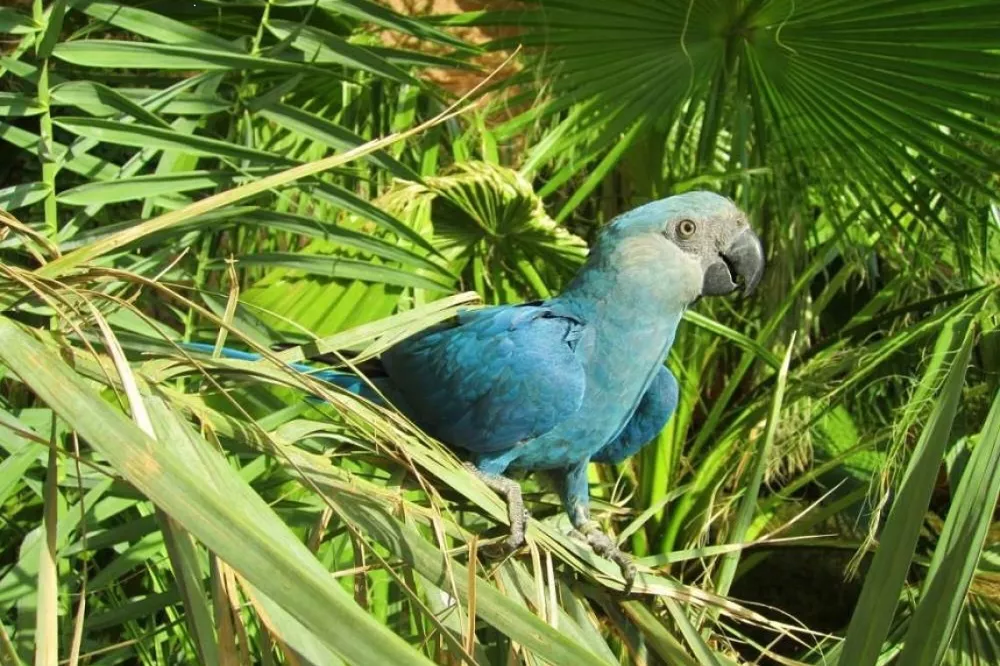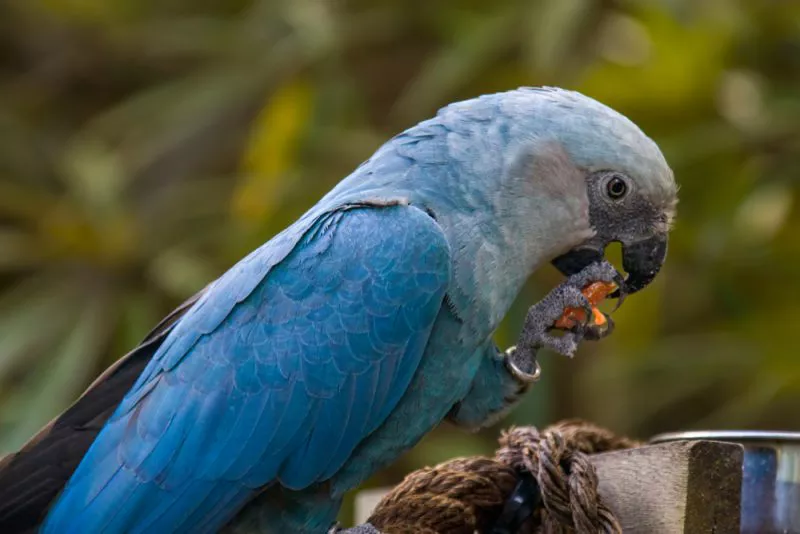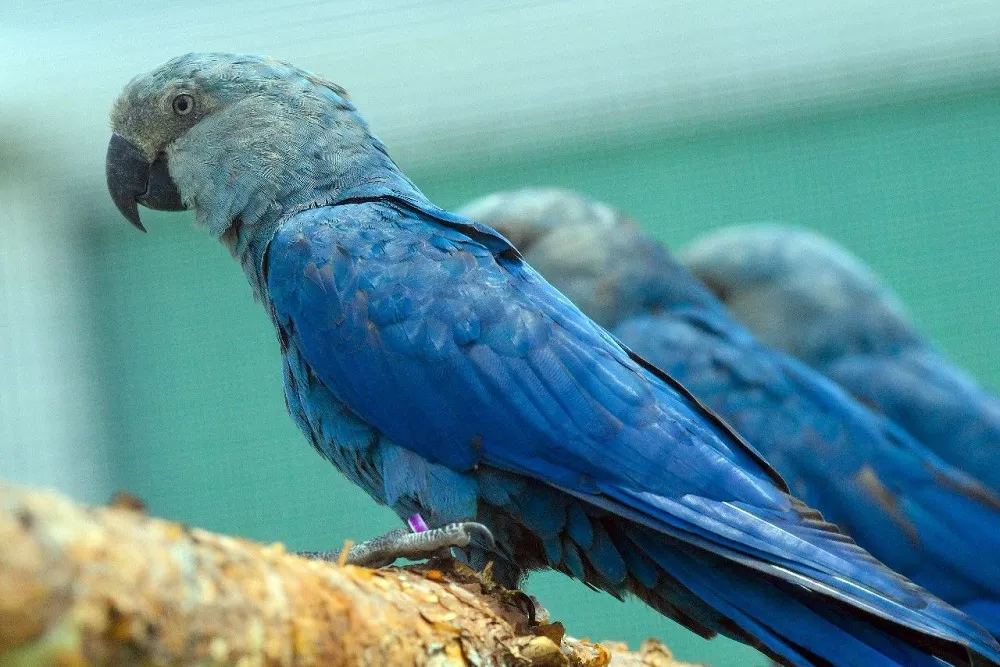
Spix’s Macaw Physical Characteristics
The Spix’s Macaw is a striking and rare bird known for its vivid coloration and distinctive features. This species, which was once thought to be extinct in the wild, is primarily recognized for its vibrant blue feathers and unique physical traits. The blue macaw has a notable thin voice, contrasting with the calls of larger macaws. Male and female Spix’s Macaws look similar, although females may be slightly smaller. Juvenile birds feature a distinctive white stripe down the center of their beaks, which disappears after 1–2 years.
Size and Dimensions
Length: The Spix’s Macaw typically reaches around 55 cm (21.5 inches) in total length.
Wingspan: Its wingspan is approximately 1 meter (39 inches).
Weight: The average weight is between 300-400 grams (10.5-14 ounces).
These birds are considered medium-sized within the macaw family, which includes larger species like the Hyacinth Macaw.
Plumage and Coloration
Body Color: The most defining characteristic of the Spix’s Macaw is its blue plumage, which covers the entire body. The feathers range from light blue on the underside to a darker, rich blue on the back and wings.
Head and Face: Its face is a light bluish-gray, with a characteristic bare, white eye-ring around the eyes, giving it an almost mask-like appearance. This distinct feature is often paired with the bird’s expressive, almond-shaped dark eyes.
Beak: The beak is large, dark gray to black, and strong, characteristic of macaws, designed to crack open hard seeds and nuts.
Tail and Flight Feathers
Tail: Spix’s Macaw has a long, pointed tail that extends much longer than the body, contributing to its aerodynamic shape for strong flight.
Flight Feathers: The flight feathers are a darker shade of blue compared to the body, giving the bird a distinctive appearance when in flight.
Spix’s Macaw Habitat
Location
Spix’s Macaws are native to northeastern Brazil, particularly in the state of Bahia. The Brazilian state of Bahia is crucial for the conservation and reintroduction efforts of these endangered birds. Their natural habitat is the Caatinga, a dry, thorny scrubland unique to this area. Within the Caatinga, they favor areas along seasonal rivers where Caraibeira trees (Tabebuia aurea) grow. These trees provide essential nesting sites and food sources.
Environment
The Caatinga is characterized by its arid climate, with sparse vegetation including thornbushes, cacti, and succulents. The presence of seasonal watercourses supports the growth of Caraibeira trees, which are crucial for the macaw’s survival. This specialized habitat contributes to the bird’s limited distribution and vulnerability.
Spix’s Macaws Diet
Spix’s Macaws primarily consume a diet rich in seeds and nuts, with a focus on the native vegetation of their habitat, the Caatinga region in Brazil. Their diet includes seeds from various trees such as:
- Pinhão (Jatropha pohliana var. mollissima)
- Favela (Cnidoscolus phyllacanthus)
- Joazeiro (Ziziphus joazeiro)
- Baraúna (Schinopsis brasiliensis)
- Imburana (Commiphora leptophloeos or Bursera leptophloeos)
- Caraibeira (Tabebuia caraiba)
- Angico (Anadenanthera macrocarpa)
- Umbu (Spondias tuberosa)
- Unha-de-gato (Acacia paniculata).
In captivity, Spix’s Macaws are fed a variety of foods including seeds, fruits, nuts, and sometimes small amounts of meat, supplemented with vitamins and minerals to ensure a balanced diet.
Spix’s Macaw Lifespan
The lifespan of the Spix’s Macaw varies depending on whether it is in the wild or in captivity.
In the wild, the lifespan is estimated to be at least 20 years, although some sources suggest it could be 20-50 years. However, due to the species’ extinction in the wild, this data is limited.
In captivity, Spix’s Macaws can live between 20 to 40 years, with an average lifespan of 28–29 years. The oldest recorded individual lived to be 35 years old.
Spix’s Macaws Photos
Reproduction and Breeding
Nesting
Spix’s Macaws nest in hollows of large Caraibeira trees. They often reuse the same nesting sites annually. The breeding season typically occurs from November to March, aligning with the rainy season in the Caatinga.Egg Laying and Development
In the wild, females lay about three eggs per clutch. In captivity, clutches can range from one to seven eggs, with an average of four. The incubation period lasts 25–28 days, and only the female incubates the eggs. Chicks fledge at around 70 days old and become independent between 100–130 days.Spix’s Macaw Population
The Spix’s Macaw, a critically endangered species, has seen significant developments in recent years, particularly in efforts to restore its wild population. Wild Spix’s macaws historically inhabited riparian Caraibeira woodland galleries in the Caatinga dry forest climate in Brazil.
Efforts to conserve the Spix’s Macaw also involve engaging the local population through awareness and education initiatives, constructing a reproduction and readaptation center, and fostering a community that understands the ecological significance of the macaw.
Conservation Status
Extinction in the Wild
Due to habitat destruction and illegal trapping for the pet trade, Spix’s Macaws were declared extinct in the wild in 2000. The last known wild male disappeared that year. The species is listed as “Extinct in the Wild” by the IUCN and is protected under CITES Appendix I, prohibiting international trade except for conservation purposes. The Spix’s Macaw was declared extinct in the wild by the IUCN in 2019.
Captive Population
As of recent reports, approximately 180 Spix’s Macaws exist in captivity worldwide. These birds are part of coordinated breeding programs aimed at increasing their numbers and genetic diversity. An international breeding program is crucial for boosting their population and ensuring their survival. The largest captive population of Spix’s Macaws is held in Germany by the Association for the Conservation of Threatened Parrots (ACTP). Key institutions involved include the Association for the Conservation of Threatened Parrots (ACTP) and the Brazilian government’s Instituto Chico Mendes de Conservação da Biodiversidade (ICMBio). This international breeding program is managed by organizations such as ICMBio and Al Wabra Wildlife Preservation, playing a critical role in conserving the macaw and restoring its natural habitat.
Reintroduction Program
Return to the Wild
In June 2022, 52 Spix’s Macaws were reintroduced into their natural habitat in Brazil’s Caatinga region. This marked a significant milestone in conservation efforts. The reintroduction involved collaboration between international organizations and local communities. The project of the reintroduction of the Spix’s macaw in Brazil included the creation of two protected areas in the state of Bahia: the Wildlife Refuge of Spix’s macaw, in Curaçá, and the Environmental Protection Area of the Spix’s macaw, in Juazeiro. Ten more Spix’s Macaws were released in December 2022 following the initial release.
Challenges
Despite these efforts, challenges remain. Climate change has led to increased aridity in the Caatinga, threatening the availability of food and nesting sites. Additionally, some reintroduced birds have succumbed to predation or have gone missing. Efforts are ongoing to monitor the population and improve survival rates.
Importance of Conservation Efforts
Biodiversity
The Spix’s Macaw plays a vital role in its ecosystem, particularly in seed dispersal, which contributes to forest regeneration. Protecting this species helps maintain the ecological balance of the Caatinga biome. The species faced significant habitat challenges due to the anthropic introduction of predatory species like black rats and feral cats.
Cultural Significance
Beyond its ecological role, the Spix’s Macaw holds cultural importance in Brazil and has become a symbol of conservation efforts worldwide. Its story has raised awareness about the impacts of habitat destruction and the importance of preserving biodiversity.
Conclusion
The Spix’s Macaw’s journey from the brink of extinction to reintroduction into the wild is a testament to the power of conservation. While challenges persist, continued efforts by scientists, conservationists, and local communities offer hope for the survival of this remarkable bird. Protecting the Spix’s Macaw ensures that future generations can witness the beauty of the Little Blue Macaw in its natural habitat.8 facts about the Spix’s Macaws
Here are 8 key facts about the Spix’s Macaw:
1. Scientific Classification: The Spix’s Macaw is scientifically known as Cyanopsitta spixii. It belongs to the family Psittacidae and is part of the tribe Arini in the subfamily Arinae.
2. Common Name: It is also known as the Little Blue Macaw due to its vibrant blue plumage.
3. Appearance: The bird measures about 55-56 cm (21.7-22 inches) in length, with a grey-blue head, pale blue underparts, and vivid blue upperparts. It has pale yellow eyes and a black, curved beak.
4. Habitat: Historically, Spix’s Macaws inhabited the desert woodlands of Brazil, specifically the Caatinga region.
5. Diet: In the wild, they were primarily herbivores, consuming seeds, fruits, and other plant materials. In captivity, their diet includes seeds, fruits, nuts, and supplements.
6. Behavior: These birds are monogamous, mating for life. They are diurnal, active during the day, and follow a precise daily routine.
7. Vocal Abilities: Spix’s Macaws are known for their ability to mimic human voices, which contributed to their popularity in the illegal pet trade.
8. Life Expectancy: In captivity, Spix’s Macaws can live up to 34 years.
You May Also Like
Spix’s Macaw, also known as the Little Blue Macaw or Cyanopsitta spixii, is a rare and endangered bird species native to Brazil. This beautiful parrot has captured the hearts of …
Spix’s Macaw, also known as the Little Blue Macaw, is a rare, critically endangered species of bird that is native to Brazil. These stunning birds are best known for their …
Macaws are known for their vibrant colors and playful personalities. They are one of the most popular parrot species, and their beauty and intelligence make them a favorite among pet …




 Facebook
Facebook  Instagram
Instagram  Youtube
Youtube 